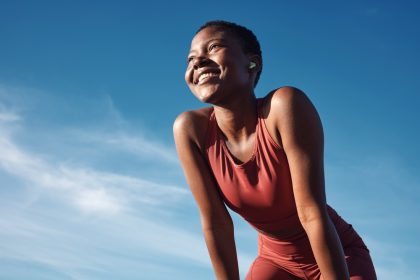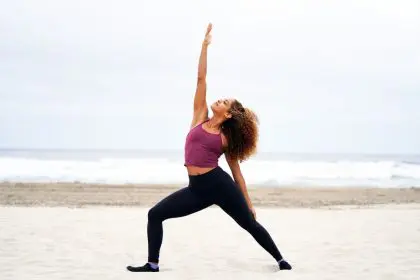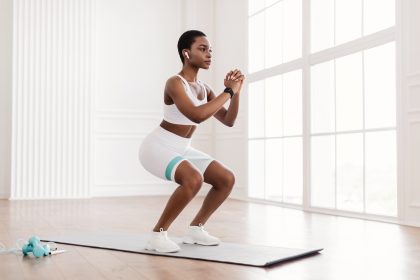Watch a toddler play and you’ll witness something remarkable – they naturally drop into a perfect deep squat, staying there comfortably for minutes while exploring toys or simply observing the world. Their heels remain planted, their spine stays straight, and they look completely at ease in a position that most adults find impossible to achieve, let alone maintain.
This natural movement that we lose somewhere between childhood and adulthood represents one of humanity’s most fundamental positions. For thousands of years, humans spent significant portions of their day in deep squats – resting, working, eating, and socializing in this primal position. Our modern lifestyle has largely abandoned this ancestral posture, and our bodies are paying the price in ways we’re only beginning to understand.
The mobility masterpiece your body was designed for
The deep squat position – where your hips drop below your knees while your heels remain flat on the ground – represents the pinnacle of human mobility. This isn’t just an exercise or stretch, but a fundamental movement pattern that your body was architecturally designed to perform with ease and comfort.
In a perfect primal squat, your ankles demonstrate optimal dorsiflexion, your knees track properly over your toes, your hips achieve maximum flexion, and your spine maintains its natural curves. This position requires coordination between virtually every joint in your lower body, making it a comprehensive assessment of your overall mobility and movement quality.
When you can comfortably hold a deep squat, it indicates that your fascial networks, joint capsules, and muscle groups are all functioning harmoniously. The position demands adequate flexibility in your calves, proper hip socket mobility, sufficient spinal extension, and coordinated muscle activation throughout your core and lower body.
Most modern adults struggle with this position because our lifestyle has systematically shortened and tightened the very tissues that make deep squatting possible. Hours spent in chairs, elevated toilet seats, and shoes with raised heels have gradually reduced our capacity for this fundamental human movement.
Your digestive system’s forgotten reset button
Perhaps nowhere are the benefits of primal squatting more pronounced than in digestive health. This position optimally aligns your intestinal tract for efficient elimination, essentially putting your body in its preferred configuration for bowel movements.
In the squatting position, your puborectalis muscle – which normally maintains a tight angle around your rectum – relaxes and straightens the pathway for waste elimination. This natural alignment reduces the strain and effort required for complete evacuation, potentially preventing many of the digestive issues that plague modern populations.
The compression created by deep squatting also provides natural massage to your abdominal organs, stimulating digestive processes and potentially improving overall gut function. This gentle internal pressure encourages the movement of food through your digestive tract and may help prevent the sluggish digestion that often accompanies sedentary lifestyles.
Many cultures that maintain traditional squatting practices report significantly lower rates of constipation, hemorrhoids, and other digestive disorders compared to populations that primarily use elevated toilet seats. This correlation suggests that our modern bathroom habits might be contributing to widespread digestive dysfunction.
The hip mobility that unlocks athletic potential
Your hip joints represent the powerhouse of human movement, and the deep squat position provides unparalleled hip mobility development. This position takes your hips through their complete range of motion, addressing restrictions that commonly develop from prolonged sitting and limited movement patterns.
The deep squat specifically targets hip flexion, external rotation, and abduction simultaneously – a combination rarely achieved in typical exercise routines. This comprehensive hip opening can translate into improved performance in virtually every athletic endeavor, from running and jumping to throwing and striking.
Many movement professionals consider the ability to achieve and maintain a comfortable deep squat as the foundation for all other athletic movements. If your hips can’t access their full range of motion in this fundamental position, compensations will inevitably occur throughout your movement patterns, potentially leading to pain and decreased performance.
The hip opening achieved through regular deep squatting also helps counteract the chronic hip flexor tightness that develops from sitting. These shortened hip flexors can pull on your lower back, contribute to poor posture, and limit your ability to generate power from your hips during athletic activities.
Spine health that chairs can’t provide
While chairs might seem like they’re supporting your spine, prolonged sitting actually places your vertebrae in compromised positions that can lead to long-term problems. The deep squat position, by contrast, naturally aligns your spine and provides the kind of spinal health benefits that no amount of ergonomic seating can match.
In a proper deep squat, your spine maintains its natural curves while being gently decompressed. The position encourages proper alignment from your tailbone to the crown of your head, essentially providing a natural spine reset that counteracts the forward head posture and rounded shoulders common in modern life.
The active muscle engagement required to maintain the squat position also strengthens your deep spinal stabilizers – the small muscles that support proper vertebral alignment. These muscles often become weak and inactive from too much passive sitting, contributing to back pain and postural problems.
Regular deep squatting can help decompress your spinal discs, which become compressed and potentially damaged from prolonged sitting. The position allows for natural disc hydration and can help maintain the spacing between vertebrae that’s essential for healthy spine function.
Circulation boost that fights modern stagnation
One of the most immediate benefits of adopting primal squatting is its powerful effect on circulation. The position naturally promotes blood flow return from your extremities while providing gentle compression that helps move lymphatic fluid throughout your body.
Unlike sitting, where blood can pool in your lower legs and circulation becomes sluggish, the deep squat position actively engages your muscle pumps – particularly in your calves and thighs – to promote venous return. This enhanced circulation can help prevent the swelling, numbness, and vascular problems associated with prolonged sitting.
The lymphatic system, which relies on muscle movement to circulate immune-supporting fluid throughout your body, particularly benefits from the deep squat position. The gentle compression and release created by settling into and rising from the squat helps pump lymphatic fluid, potentially boosting immune function and reducing inflammation.
This circulation boost extends to your pelvic region as well, where improved blood flow can support reproductive health, reduce pelvic tension, and potentially alleviate some of the discomfort associated with conditions like chronic pelvic pain syndrome.
Mental clarity through movement meditation
The deep squat position offers unique opportunities for mindfulness and stress reduction that conventional seating simply cannot provide. Holding this position requires present-moment awareness of your body, breath, and balance, naturally drawing your attention away from mental stress and into physical presence.
Many meditation traditions incorporate squatting positions precisely because they promote alertness while remaining comfortable for extended periods. Unlike sitting meditation, which can sometimes promote drowsiness, the active engagement required for squatting maintains mental clarity while encouraging relaxation.
The grounding effect of having your feet flat on the earth while in a stable, supported position can be particularly calming for your nervous system. This connection to the ground, combined with the open hip position, often creates feelings of stability and centeredness that translate into improved mental well-being.
Regular practice of holding deep squat positions can also build mental resilience and body awareness. Learning to remain calm and breathe deeply while holding a challenging position develops both physical and psychological tools for managing stress and discomfort in other areas of life.
The ankle mobility that modern shoes steal
Your ankles are meant to be highly mobile joints capable of significant dorsiflexion – the ability to bring your shins toward your feet. Modern footwear, particularly shoes with raised heels, gradually reduces this essential mobility, contributing to a cascade of movement problems throughout your body.
The deep squat position requires and develops maximum ankle dorsiflexion, essentially undoing years of restriction from elevated footwear. This improved ankle mobility has far-reaching effects on your movement quality, potentially reducing knee pain, improving walking mechanics, and enhancing overall lower body function.
When your ankles can’t move properly, your body compensates by altering movement patterns at your knees, hips, and spine. These compensations often lead to pain and dysfunction in joints far removed from the actual restriction. Restoring ankle mobility through deep squatting can resolve issues throughout your kinetic chain.
The calf muscle flexibility developed through regular deep squatting also has implications for circulation and injury prevention. Tight calf muscles can contribute to plantar fasciitis, Achilles tendon problems, and even circulatory issues. The gentle, sustained stretch provided by squatting helps maintain the calf flexibility essential for healthy lower leg function.
Social and cultural benefits of ground-based living
Beyond the physical benefits, adopting more primal squatting in your daily life can reconnect you with fundamental human movement patterns and potentially improve your relationship with your environment. Many cultures that maintain traditional squatting practices report stronger community bonds and more grounded connections to their surroundings.
Spending time in positions closer to the earth naturally encourages different perspectives on your environment and can foster feelings of connection and stability. The squatting position also facilitates better interaction with children, who naturally operate at this level, potentially improving family dynamics and communication.
From a practical standpoint, the ability to comfortably squat opens up new options for rest and work in environments where chairs aren’t available. This adaptability can be particularly valuable when traveling, camping, or working in non-traditional settings.
The confidence that comes from knowing your body can handle fundamental human positions also contributes to overall well-being and body trust. Many people report feeling more physically capable and confident after developing their squatting ability.
Practical integration into modern life
Reintroducing primal squatting into your routine doesn’t require dramatic lifestyle changes or extended time commitments. Small, consistent practices can gradually restore your body’s natural squatting ability while providing immediate benefits.
Start by incorporating short squatting holds into your daily routine – perhaps while waiting for coffee to brew or during television commercial breaks. Even 30-60 seconds of squatting can provide circulation benefits and begin improving your mobility.
Many daily activities can be performed in squatting positions instead of sitting or standing. Gardening, playing with children, or organizing low shelves become opportunities to practice and maintain your squatting ability while accomplishing other tasks.
For those with limited mobility, modifications like holding onto a doorframe or placing a pillow under your heels can make the position accessible while you gradually develop the flexibility and strength for unsupported squatting.
Creating environmental cues can help establish squatting habits. Designating specific times or locations for squatting practice helps integrate this ancestral movement into your modern routine without requiring major lifestyle disruptions.
The restoration timeline you can expect
Rebuilding your squatting ability is a gradual process that unfolds in predictable stages. Understanding this timeline can help maintain motivation while preventing the frustration that often comes from expecting immediate results.
Most people begin noticing improved ankle mobility within the first few weeks of regular practice. This initial improvement makes the squatting position more comfortable and accessible, encouraging continued practice and progression.
Hip mobility improvements typically become apparent within 4-6 weeks of consistent practice. You may notice easier movement in daily activities, reduced stiffness when rising from chairs, and improved comfort in positions requiring hip flexion.
The deeper benefits – improved digestion, enhanced circulation, and better overall movement quality – often manifest after 2-3 months of regular squatting practice. These systemic improvements reflect your body’s adaptation to this fundamental movement pattern.
Long-term practitioners often report that squatting becomes not just comfortable but genuinely enjoyable – a position they actively seek out for rest, reflection, and rejuvenation. This transformation from challenge to preference marks the successful reintegration of this primal movement into modern life.
Your ancestors spent significant portions of their lives in deep squat positions not because they lacked furniture, but because this position provided benefits that no chair, regardless of its ergonomic design, could match. By reclaiming this fundamental human movement, you’re not just improving your physical health – you’re reconnecting with movement patterns that have supported human well-being for millennia.















